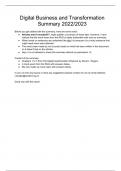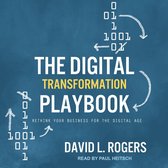Digital Business and Transformation
Summary 2022/2023
Before you get started with this summary, here are some notes:
● Articles aren’t included!!! I might publish a summary of these later. However, I have
noticed that the mock exam from the RUG is easily achievable with only my summary.
● When words or sentences are underlined like this it is because it is a tricky sentence that
might need some extra attention.
● The mock exam made by me is purely based on what has been written in this document,
so it doesn’t test on the articles.
● Also, it is not allowed to share this summary without my permission <3.
Content of the summary:
● Chapters 1 to 7 from The Digital transformation Playbook by David L. Rogers.
● A mock exam from the RUG with answers below.
● My own made up mock exam with answers below.
In you run into any issues or have any suggestions please contact me via my email address:
l.booijen@student.rug.nl
Good luck with the exam!
,Week 1
Literature
● Article → Verhoef, P. C., Broekhuizen, T., Bart, Y., Bhattacharya, A., Dong, J. Q.,
Fabian, N., & Haenlein, M. (2021). Digital transformation: A Multidisciplinary Reflection
and Research Agenda. Journal of Business Research, 122, 889–901.
● Book → Chapter 1
Chapter 1
There are 5 domains of digital transformation:
● Customers
● Competition
● Data
● Innovation
● Value
Customers
Customer communications and reviews make them a bigger influencer than advertisements or
celebrities, and such customers' dynamic participation has become a critical driver of business
success. Customers today are constantly connecting with and influencing each other and
shaping business reputations and brands.
Competition
More and more, we are competing not just with rival companies from within our industry, but
also with companies from outside our industry that are stealing customers away with their new
digital offerings. Also, competitive assets may no longer rise in our own organization; rather,
they may be in a network of partners that we bring together in looser business relationships.
Most importantly, digital technologies are supercharging the power of platform business models,
which allow one business to create and capture enormous value by facilitating the interactions
between other businesses or customers.
Data
Today data is being generated at an unprecedented rate by everyone. Also, cloud-based
systems for storing data are increasingly cheap. The biggest challenge today is turning the
enormous amount of data we have into valuable information. Every business now has access to
a river of unstructured data that is generated without planning and that can increasingly be
utilized with new analytical tools. This unlocks new sources of value. Data is a vital part of how
every business operates, differentiates itself in the market and generates value.
Innovation
Digital technologies enable continuous testing and experiencementation, processes that were
inconceivable in the past. Constant learning is becoming the norm.
,Value
What customers value can change very quickly. Constantly pushing the envelope to find our
next source of customer value is now an imperative. Rather than waiting to adapt when change
becomes a matter of life or death, businesses need to focus on seizing emerging opportunities.
The digital transformation Playbook
Domains Strategic themes Key concepts Explanation
Customers Harness customer ● Reinvented There are customer
networks marketing funnel networks, customers
● Path to purchase aren’t isolated.
● Core behaviors Collaborate with
of customer customers directly.
networks
Competition Build platforms, not ● Platform Become a trusted
just products business models intermediary who
● (In)direct network brings together
effects competing
● (dis)intermediatio businesses. Open up
n a proprietary product
● Competitive for others to build on.
value trains Learn when and when
to cooperate with
competitors.
Data Turn data into assets ● Templates of Assemble the right
data value data. Collaborate with
● Drivers of big data partners. Which
data customers require
● Data-driven more attention. Data
decision making helps to find partners.
Innovation Innovate by rapid ● Divergent Continuous testing.
experimentation experimentation Rapid learning. Use
● Convergent prototypes to explore
experimentation new products. Rapid
● Minimum viable experimentation
prototype involving rigorous
● Paths to scaling testing of an
up innovation’s
assumption.
Value Adapt your value ● Concepts of Continuous
proposition market value reconfiguration of a
● Paths out of a business may involve
declining market discovering new
● Steps to value customers and
prop evolution applications. Evolve
offerings. Experiment
with new ways of
engagement.
, There are 9 tools for digital transformation:
● Customer Network Strategy Generator (ch.2)
● Platform Business Model Map (ch.3)
● Competitive Value Train (ch.3)
● Data Value Generator (ch.4)
● Convergent Experimental Method (ch.5)
● Divergent Experimental Method (ch.5)
● Value proposition Roadmap (ch.6)
● Disruptive Business Model Map (ch.7)
● Disruptive Response Planner (ch.7)
These tools can be categorized as follows:
● Strategic ideation tools: Tools for generating a new solution to a defined challenge by
exploring different facets of a strategic phenomenon (Customer Network Strategy
Generator, Data Value Generator)
● Strategy maps: Visual tools that can be used to analyze an existing business model or
strategy or to assess and explore a new one (Platform business Model Map, Competitive
Value Train, Disruptive BUsiness Model Map)
● Strategic decision tools: Tools with criteria for evaluating and deciding among a set of
generic options available for a key strategic decision (Disruptive Response Planner)
● Strategic planning tools: Step-by-step planning processes or methods that can be
used to develop a strategic plan tailored to a specific business context or challenge
(Convergent Experimental Method, Divergent Experiment Method, Value Proposition
Roadmap).





